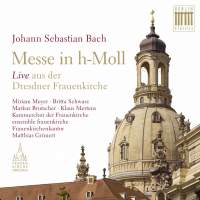Texte paru dans: / Appeared in: |
|
|
Outil de traduction ~ (Très approximatif) |
|
|
Reviewer: Joshua Cohen “The Mass in B-minor,” writes Teri Noel Towe in Choral Music on Record (Cambridge, 1991), “is best thought of as an anthology, a collection of his ‘best’ sacred music assembled by Bach in the last years of his life.” From a purely musicological standpoint, one would have to agree. Starting with the Kyrie and Gloria—composed by Bach in 1733 and sent as part of his musical portfolio to the new Elector of Saxony—the complete Mass gradually took form over the next 15 years, drawing together new music composed in the late 1740s with reworkings of earlier compositions dating back as far as 1714. The entire piece was not performed until 1859, over a century after the composer’s death. What difference does all this make, however, to musicians responsible for bringing the work to life in performance? Should performers treat the Mass as the anthology it technically is, and serve up a kind of high-end “greatest hits” concert? Or should they regard it as millions of listeners (mercifully ignorant of its compositional history) have done before, as the final masterpiece of the greatest composer of sacred music in the Western classical tradition? I’m sure Towe would agree with me that the most memorable performances, whether “live” or in the studio, have been guided by an overarching conception of what the work as a whole is trying to say, and where it will have taken us by the time it reaches its conclusion. Starting with this unified conception, strong interpretations have come in a variety of forms. Like Towe himself, I’ve been delighted, stimulated, and sometimes moved by performances using large forces or small, modern or original instruments, prevailingly fast or slow tempos. I love the airborne freshness and sweet candor of Rifkin’s controversial one-voice-to-a-part version on Nonesuch (1981); I’ve also been stirred by Klemperer’s monumental reading on EMI (1967). But to do justice to the B-Minor Mass, it is necessary to approach it as something bigger and more profound than a choral “showcase.” Since his appointment in 2004 as first Kantor of the restored Frauenkirche in Dresden, Matthias Grünnert has assembled a crack ensemble of singers and instrumentalists trained to tackle a wide-ranging repertory, but with special emphasis on sacred music from the Baroque and Classical periods. Grünnert employs a mixed chamber choir of about 30 singers and a small band of professional players from the Dresden Staatskapelle and Philharmonic Orchestras, both of which he has coached in the stylistic gestures and manners cultivated by the early instrument movement. In this “live” recording made in 2014, Grünnert secures brisk, energetic tempos, a fresh, outgoing choral sound, and cultured instrumental work. The slower, more mystical movements, “Qui Tollis” and “Et Incarnatus,” are beautifully done: poised, ethereal, and mysterious. Three of soloists sing attractively, with trim, flexible voices, if somewhat neutral in expression. Veteran baritone Klaus Mertens still sounds steady and dignified at 65, though his two arias call for a fluidity and grace that was never his strongest suit (Max van Egmond sets the standard here). The recording is close but well balanced. What is missing, for the most part, is a feeling for the liturgy: the words that this music has been composed (or selected) to express. This is just the kind of crisp, upbeat concert performance that never falls flat, yet leaves no enduring impression. My own record library is stocked with older versions, of which my favorites are the Rifkin and Klemperer sets mentioned earlier and the first early instrument recording (1968) led by Nikolaus Harnoncourt (directing the orchestra) and Hans Gillesberger (conducting the choir). I’ve lent out (and thereby lost) Gardiner’s sleek, sharp-cut version from 1986 and Rilling’s second recording (2000), with splendid singing by the Gächinger Kantorei and an eloquent alto soloist (Ingeborg Danz). I have also found things to admire in “historically informed” versions by Bernius (2010) and Suzuki (2007), in Karl Richter’s sturdy conviction (1961), and, above all, in the sterling musicianship and steady vision of Robert Shaw (1960). If forced to choose one, though, I’d happily live with Rifkin’s “B-Minor Madrigal” (as the press facetiously called it), at once the most intimate and the most uplifting performance I’ve yet heard. | |
|
|
|
|
Cliquez l'un ou l'autre
bouton pour découvrir bien d'autres critiques de CD |
|




